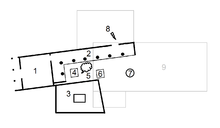Pandroseion
The Pandroseion ( Greek Πανδρόσειον ) was a temple on the Acropolis of Athens . It was consecrated to Pandrosus , daughter of Kekrops I , who was considered the first priestess of the goddess Athena . It stood on the north side of the Acropolis plateau - the scene of the most important Attic myths. The oldest structural remains from the Mycenaean period were also found in this area . In addition to the dew goddess Pandrosus ( Greek δρόσος dew ), Thallo ( Greek Θαλλώ = the flower-bringer) another fertility goddess is worshiped.
description
In the west of the Temenos stood the actual temple of the Pandrosos. It was a 6.50 m by 6.5 m building, of which almost nothing is left today. A rear door of the temple led to an approximately 16 m long L-shaped columned hall in Ionic order , which enclosed the inner courtyard of the sanctuary to the west and north. In the southern part of the courtyard was the grave of Kekrops I. Originally it was probably covered by a burial mound. It was later surrounded by a trapezoidal wall.
In the courtyard there was an altar for Zeus Herkeios (house protector ). Here also stood the sacred olive tree that grew on the spot where Athena had rammed her spear into the ground. 480 BC During the destruction of the temple by the Persians , the olive tree was burned. But just one day later it is said to have produced a shoot two cubits long. The olive tree was interpreted as a symbol of the invincibility of Athens. The olive tree that grows here today was planted there by the Greek Queen Sophie of Prussia around 1900.
The location of the trough in which the salt water collected after being hit by Poseidon's trident has not yet been precisely determined. It is also called the Salt Sea of Poseidon , Salt Sea of Erechtheus or Erechtheïs . In the eastern part of the Temenos was the tomb of Erechtheus. The sacred mountain snakes are said to have been there too. The inner courtyard was bordered in the south by the terrace wall of the Old Athena Temple . A door in the northern rear wall of the portico led to the rock with the trident mark . Here Poseidon is said to have pushed the trident into the ground. According to another tradition, the marks in the rock were made by Zeus' lightning strike when he killed Erechtheus.
480 BC The temple was destroyed and soon rebuilt. Around 421 BC BC began with the building of the Erechtheion . The western part of the Erechtheion was built over the eastern Pandroseion. The Temenos of the Pandrosos was integrated into the new building and now appeared more as part of the Erechtheion. At that time, the sanctuary's courtyard was also paved.
literature
- Wilhelm Dörpfeld : Erechtheion. Drawings and editing by Hans Schleif . , Berlin 1942 ( online )
- Brian de Jongh: Greece . Prestel, Munich 1974, ISBN 3-7913-0042-3 , pp. 43-47 .
- Richard Speicher: Southern Greece. Art and travel guide, Volume 1 Athens, Attica, Boeotia, Phocis, Phthiotis and Euboea. Stuttgart et al. (Kohlhammer) 1978, ISBN 3-17-004690-X , p. 99
- Baedeker Alliance Travel Guide: Athens . 8th edition. Karl Baedeker, Ostfildern 2002, ISBN 3-87504-133-X , pp. 78-79.
Web links
Individual evidence
Coordinates: 37 ° 58 ′ 19.5 ″ N , 23 ° 43 ′ 34.3 ″ E


